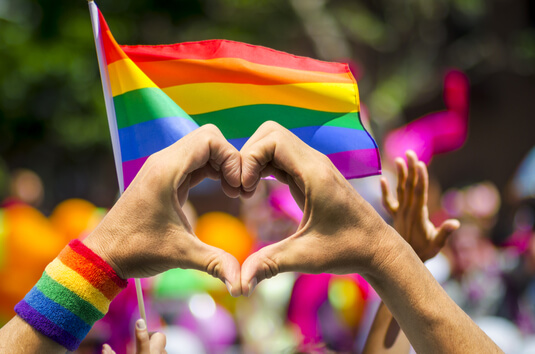The 1960s witnessed an increased drive to publicly assert sexual identity, and events at the end of the decade helped forge a full-fledged movement in the U.S. and other countries.
 © Shutterstock/lazyllama
© Shutterstock/lazyllamaComing out
As a result of the women's movement and the increasing overt nature of sexuality in society, as well as the high visibility of the civil rights and antiwar movements, gay men and women began to feel more comfortable about asserting who they were and demanding the right to be treated equally to other citizens.The 1960s began a time when women felt more comfortable exploring and enjoying their sexuality, which then fostered a freer atmosphere for others to explore individual sexuality as well. And when gay people saw this change happening, they began to believe that they, too, could advocate for their own rights. They were tired of being "in the closet," pretending to be heterosexual in order to keep their jobs, families, and friends.
Americans began publicly discussing homosexuality after the 1948 publication of Alfred Kinsey's book, Sexual Behavior in the Human Male, which said that approximately 10 percent of males have a homosexual experience in their lives.
The most visible sign of gay activism during the 1950s and early 1960s was an increased willingness for gay men and women to come out of the closet and identify themselves as homosexuals, even to a straight society. They began to congregate in gay communities in large cities and in gay bars, which were long considered a hotbed of immorality.
Gay people became less willing to be considered social outcasts, and by the late 1960s, the community began to demand equal treatment with heterosexuals. At that time, the main focus was on ending discrimination, repealing "sodomy" and other repressive laws, and changing the public view that homosexuality is a sin.
In more recent years, the scope of LGBTQ+ activism expanded to include freedom from hate crimes, equal employment and housing opportunities, the right to serve openly in the military, and most recently, gay marriage.
Rioting at the Stonewall bar
Before 1965, raids on gay bars were fairly routine. However, that year a politically involved gay activist — Dick Leitsch of the Mattachine society, a gay rights organization dedicated to improving homosexuals' lives and working for equality — challenged the New York State Liquor Authority (SLA), which had a policy of taking away the liquor license of any bar serving three or more homosexuals at one time.In 1966, after alerting the media, Leitsch held a "sip-in," intending to have a drink with two other gay men at a bar. When the bartender turned them away, they complained to the city's human rights commission. Embarrassed by press coverage of the event and its aftermath, the chairman of the SLA denied that the department prohibited selling liquor to homosexuals. The following year, the courts determined that the SLA couldn't revoke a liquor license without evidence of violations (which didn't include serving gay people).
However, on June 27, 1969, police thought they had a good reason to raid the Stonewall Inn, a gay bar in Greenwich Village in New York City. The police asserted that the bar didn't have a valid liquor license, had ties with organized crime, offered scantily clad boys as entertainers, and brought an unruly element to Sheridan Square. So that night, after 1 a.m., police raided the bar. Although many patrons escaped arrest, the cops nailed anyone without an ID or anyone who was cross-dressed.
The patrons were incensed, and the riot was on. Competing accounts of the chaotic event make it difficult to determine whether the riot was started by a drag queen clubbed by a policeman or a lesbian crowded into a squad car, but whatever the cause, the anger was contagious, and the crowd moved to overtake the police. The police tried to retreat into the bar, but when they grabbed and beat an innocent bystander, the violence escalated.
Some rioters set the bar on fire, and others ripped parking meters from the sidewalk to use as weapons. Soon, not only were the patrons of the Stonewall lashing out — the entire neighborhood got involved in the melee. Even a tactical force sent in to quell the riot was unable to control the angry mob, who protested throughout the night.
The crowd returned for the next few nights. Although the violence lessened as the nights wore on, the protesters, chanting "gay power!" were no less outraged at the way police had treated gay people for years.
After the Stonewall riots were over, the gay community decided to turn their anger to positive change. By the end of July, the Gay Liberation Front (GLF) was formed in New York. The Stonewall Riots mobilized the gay community — homosexuals, who were no longer content to hide at the margins of American society, started newspapers, formed community organizations, and became politically active.
By 1970, the GLF had chapters across the country. In June, it held a march to commemorate the Stonewall riots. Between 5,000 and 10,000 men and women marched from Greenwich Village to Central Park, which inaugurated the tradition of the gay pride celebration.
Today, in many American cities, gay pride parades are normally held on the last weekend in June to honor the Stonewall riots and celebrate LGBTQ+ identities and pride.
Much progress has been made for the rights of LGBTQ+ people since the 1960s. But, unfortunately, hate crimes, discrimination — including harmful legislation — continue to be realities for many in this population, even all these decades later.

